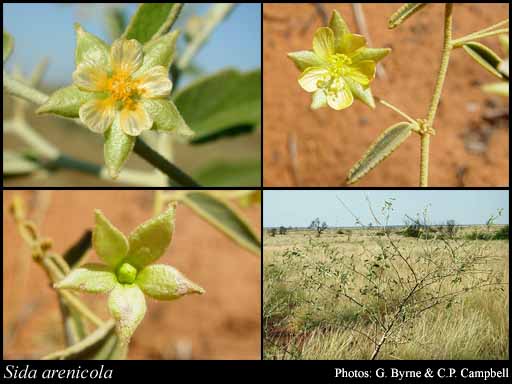- Reference
- Austrobaileya 2:463-465,Fig.4 (1988)
- Conservation Code
- Not threatened
- Naturalised Status
- Native to Western Australia
- Name Status
- Current
Upright, spindly shrub, 0.5-1.2(-2) m high. Fl. yellow, May to Oct. Sandy & clayey soils. Along drainage lines, plains, rises.

Scientific Description
Herb or shrub, with hairy stems. Leaves 10-30 mm long, 2-10 mm wide, not lobed; margins entire; hairy, with stellate hairswith scales absent, Sessile glands absent; stipules present and persistent to older leaves or present but early deciduous (only visible on youngest leaves). Perianth clearly of two whorls (calyx and corolla), the corolla obvious and prominent. Pedicel present, 8-15 mm long; indumentum present, with stellate hairs present, with scales absent. Epicalyx (extra segments or 'bracteoles' immediately below the calyx) absent. Calyx green, 7-10 mm long, the lobes fused less than half their length, Sessile glands absent, simple hairs (without tubercle bases) absent, stellate hairs present, tubercle-based simple hairs absent, gland-tipped hairs absent, scales absent, Terminal appendages absent, number of ribs absent. Corolla yellow, 5 mm long, glabrous. Indumentum (outside) Sessile glands absent. Stamens many, united and arising from a staminal tube around the style; filaments present, 1-1.2 mm long; anthers 0.4-0.5 mm long, indumentum absent (anthers glabrous). Staminodes absent, appendages absent. Ovary hairs and scales absent (ovary quite glabrous); style 1, 4 mm long, with four or numerous style branches or lobes, mostly glabrous, wing absent. Fruits indehiscent and splitting into sections (schizocarps), length-width ratio more or less as long as wide, mericarps wrinkled, hairs and scales absent, Sessile glands absent; apex distinctly flat-topped; prickles absent (except perhaps a terminal awn); terminal awns or spines absent; calyx persistent to mature fruit, not accrescent. Flowering time May, June, July, August, September or October. Distribution Botanical Province Northern or Eremaean, IBRA Bioregion Great Sandy Desert, Pilbara, Gascoyne, Little Sandy Desert, Gibson Desert, Great Victorian Desert, Dampierland and Ord-Victorian-Plain.
Distribution
- IBRA Regions
- Carnarvon, Dampierland, Gascoyne, Gibson Desert, Great Sandy Desert, Great Victoria Desert, Little Sandy Desert, Ord Victoria Plain, Pilbara.
- IBRA Subregions
- Augustus, Cape Range, Chichester, Fortescue, Hamersley, Lateritic Plain, Mackay, McLarty, Pindanland, Roebourne, Shield, South Kimberley Interzone, Trainor.
- Local Government Areas (LGAs)
- Ashburton, Broome, Derby-West Kimberley, East Pilbara, Exmouth, Halls Creek, Karratha, Laverton, Meekatharra, Port Hedland, Upper Gascoyne, Wiluna.